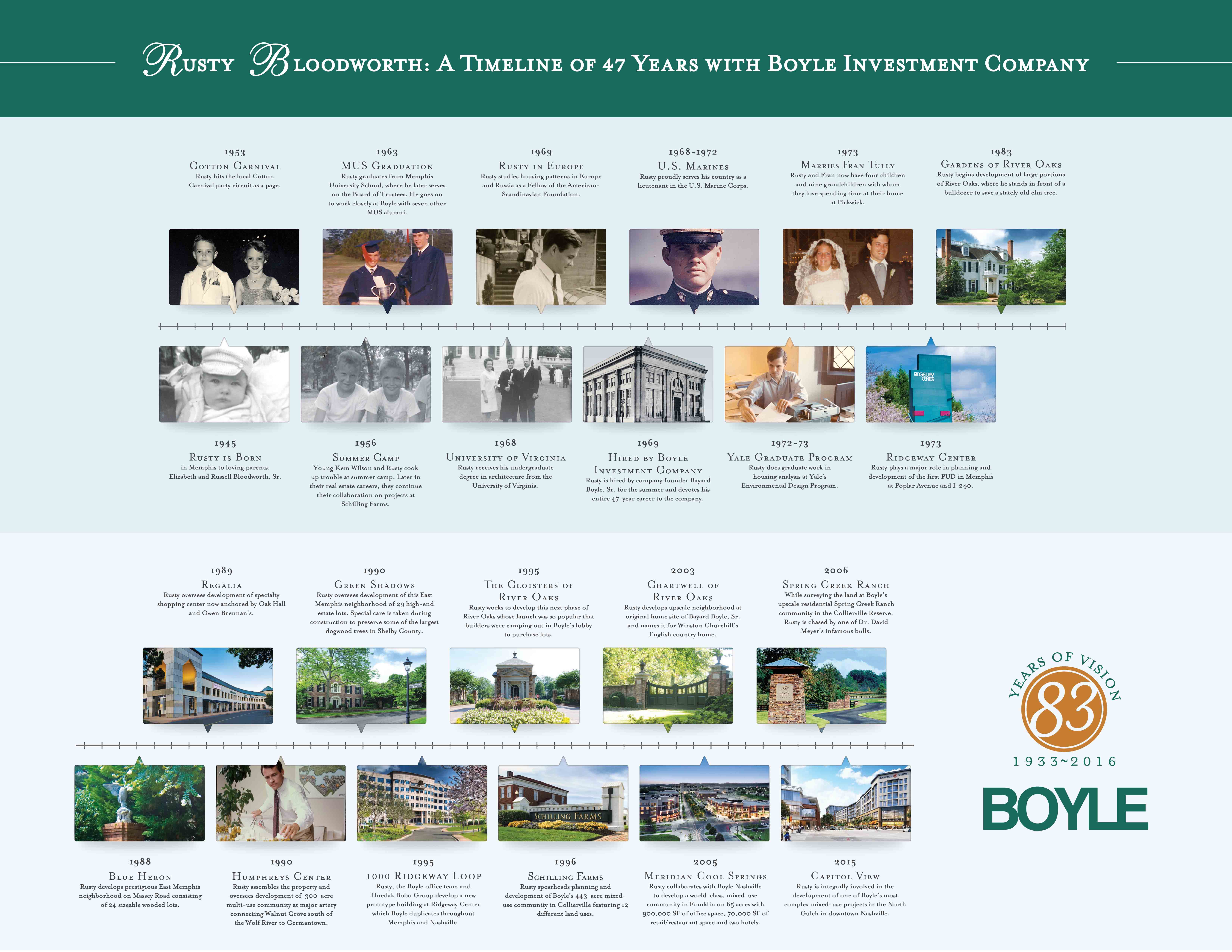November 30, 2015
Russell E. “Rusty” Bloodworth
In 1969, Russell E. “Rusty” Bloodworth was hired for a summer job by company founder Bayard Boyle, Sr. and then devoted his 47-year career to the company, whose owners, the Boyle and Morgan families, credit Rusty as being instrumental in the planning/development of major mixed-use real estate projects.
Rusty established a national reputation for meticulous planning, attention to detail, and respect for the natural environment. He helped reshape large portions of the urban landscape where thousands of Memphians live and work including the Poplar-Ridgeway area, River Oaks, Humphreys Boulevard, and Schilling Farms. His reach extends to Nashville with development of multi-use projects such as Meridian Cool Springs, Berry Farms, CityPark, and Capitol View.
“For the past 35 years Rusty has conceived, initiated and master planned most of our major projects,” says Bayard Boyle, Jr., Chairman of Boyle Investment Company. “Without him we would have been a much smaller company with far less influence on Memphis’ development.”
A native Memphian, Rusty graduated from Memphis University School and the University of Virginia, studied Environmental Design at Yale, and was an American Scandinavian Foundation Fellow and Knight Fellow at the University of Miami. He was featured in Southern Living magazine as “A Tree Fanatic in Memphis,” was inducted into MARR’s Commercial Real Estate Hall of Fame and named a Lambda Alpha Lifetime Achievement Award winner. His co-workers call him a modern-day “Renaissance man” because he excels in so many areas — painting, photography, writing, and the martial arts. This year as Rusty celebrates his 70th birthday, he is transitioning into a new role at Boyle as he enjoys semi-retirement.
Editor: You directed the planning/zoning of five major multiple-use projects in excess of 1,600 acres. What inspired you to become an architect and eventually a community developer?
Bloodworth: At age eleven I wanted to be an architect, but in college I was drawn to organizing and designing complete communities. I realized too many of an architect’s works are never created, and as a developer I could maintain more control over which projects get built.
Editor: You always take a sketchbook with you on your trips abroad. What is the most important aspect of a community and how have your travels to Europe and Scandinavia influenced the design of projects?
Bloodworth: Community is about wholeness – taking disparate parts and bringing them together so that there is true vitality, for a toddler on a tricycle to a retiree. We all want a safe, functional and beautiful environment. My time in Europe reinforced that view – particularly the Scandinavian and Finish new communities.
Editor: What role does the natural environment play in the development of Boyle’s projects?
Bloodworth: It’s the base line, the foundation for every plan, the underlying guide that points us to the proper solution. We make every effort possible to preserve the existing natural elements, especially mature trees. When a site is selected, we order a detailed topographical map with each major tree displayed by species and size; buildings and parking lots are then placed carefully on the site to allow trees plenty of elbow room.
Editor: Describe your relationship with the company’s owners and how their business philosophy has allowed you to achieve your goals.
Bloodworth: The family has provided me the freedom to implement a more cohesive vision of what community can be. In the 1970s with Ridgeway Center, we incorporated seven land uses; Schilling Farms, planned in the1990s, incorporates 12 uses. My vision has evolved and been shaped by the terrific development team we have at Boyle.
Caption for photo: Rusty is known for preserving the natural environment at all of Boyle’s projects, including this 100-year-old tree in front of Boyle’s headquarters at 5900 Poplar. Thirty-five years ago, this vibrant live oak was slated to be removed for a parking lot. It was an early intervention for Rusty.

